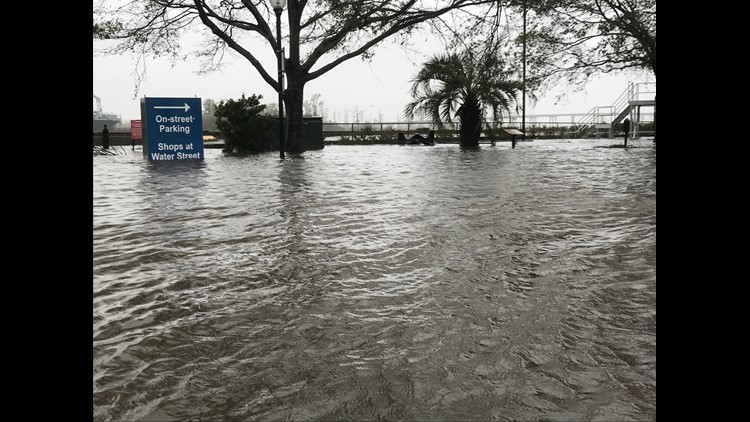Florence weakened to a tropical depression as it marched inland, unloading a powerful mix of wind and rain on the Carolinas after killing at least 13 people.
Despite its weakening Sunday from a tropical storm, its relentless rain drenched already saturated areas as authorities warned the danger is far from over.
“The flood danger from this storm is more immediate today than when it … made landfall 24 hours ago,” North Carolina Gov. Roy Cooper said Saturday. “We face walls of water at our coasts, along our rivers, across our farmland, in our cities and in our towns.”
Florence crashed ashore Friday morning in North Carolina as a Category 1 hurricane, and it has wiped out power to about 796,000 customers in that state and South Carolina.
It has trapped people in flooded homes, with citizen swift-water rescue teams from out of state joining local emergency professionals to try to bring them to safety.
Key developments
• Florence’s location: By early Sunday, Florence’s center was 20 miles southwest of Columbia, South Carolina, with maximum sustained winds of 35 mph. It was moving west at 8 mph, the National Weather Service said.
Losing strength: Florence weakened to a depression, but flash flooding and major river flooding will continue over the Carolinas.
• Looting arrests: Wilmington police said they arrested five people who allegedly looted a Dollar General store. Another person was arrested for allegedly looting an Exxon gas station and convenience store.
• No electricity: About 760,000 customers are without power in North Carolina, emergency officials said. In South Carolina, some 36,000 customers are without power, officials said.
• Much flooding to come: By storm’s end, up to 40 inches of rain will have fallen in parts of North Carolina and far northeastern South Carolina, the National Hurricane Center said. Some other parts of South Carolina could see rainfall totals of up to 15 inches, forecasters said.
• Record rainfall: Florence has dumped more than 30 inches of rain in Swansboro, North Carolina, breaking the record for rainfall from a tropical system in the state. The previous record of 24.06 inches was set during Hurricane Floyd in 1999.
13 people killed, including a child
Florence has left at least 13 people dead, including a mother and her child who died after a tree fell on their house in Wilmington, North Carolina, police said.
In Hampstead, North Carolina, emergency responders going to a call for cardiac arrest found their path blocked by downed trees. When they got to the home, the woman was dead, authorities said.
Two men were also killed in Lenoir County, North Carolina. One was killed while checking on his dogs outside while another one was electrocuted while trying to connect two extension cords, emergency officials said.
Flash flooding killed three people in Duplin County, North Carolina, the sheriff’s office there said. Also, officials in Cumberland County determined that a fire that killed two people was storm-related.
In South Carolina’s Union County, a 61-year-old woman was killed when the car she was driving struck a downed tree, state emergency management spokesman Antonio Diggs said. A man and woman died in Horry County due to carbon monoxide poisoning, according to South Carolina officials.
Flash floods and landslides
Catastrophic flash floods and prolonged significant river flooding are likely over for portions of the Carolinas into west-central Virginia and far eastern West Virginia as Florence moves slowly inland, the hurricane center said.
“In addition to the flash flood and flooding threat, landslides are also possible in the higher terrain of the southern and central Appalachians across western North Carolina into southwest Virginia,” it said.
Rapidly rising river
In Lumberton, residents warily looked at the rapidly rising river in the North Carolina city, which was submerged for days after 2016’s Hurricane Matthew.
Lumber River was rising faster than officials expected. It went up 5 feet overnight and was at 17.6 feet, more than 4 feet above flood stage, by Saturday night. It was expected to reach 24 feet by midday Sunday.
Corey Walters, the city’s deputy director of public works, said this was a worst-case storm scenario.
There is flooding “everywhere in the city,” he said. ” There have been “hundreds of rescues.”
Volunteers and city workers have been filling sandbags, trying to plug a low point in the city’s levee system before the Lumber River crests.
Official predict that when the water reaches 26 feet, the barriers will be overwhelmed.
The city installed 11 pumps to help deal with the river, but Mayor John Cantey said he wants people living near it to get out.
There is a mandatory evacuation order for the area, officials said.
In Cumberland County, which includes Fayetteville, officials ordered people within a mile of the Cape Fear River to evacuate by 3 p.m. Sunday.
States of emergency
Officials have declared states of emergency in several states, including in the Carolinas, Georgia, Virginia and Maryland, where coastal areas are still recovering from summer storms.
According to the National Hurricane Center, the storm will travel through upstate South Carolina, then turn north toward the Ohio Valley.
As it moves near Ohio and West Virginia, it will become a remnant low. Then it will swing to the northeast in the middle of next week on a path to the Atlantic Ocean near Nova Scotia, where it will be an extratropical low with gale-force winds.



